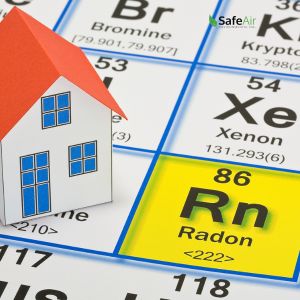What Houses Are Most at Risk for Radon
Posted in Radon Testing, on April 30, 2024
If you’ve heard about radon testing from family or friends, you may have several questions, such as “Is my home at risk?” If this sounds familiar, the SafeAir team can help explain what radon is and whether it’s likely to affect your home. Radon gas is an indoor air quality issue that affects thousands of homes across Toronto and the GTA. It’s a natural phenomenon that’s hard to predict, but it is identifiable through testing — and fixable too!
What is Radon?
 Radon is a radioactive gas created by uranium buried deep in the earth’s surface. This gas can collect in homes for several reasons, but most frequently because of the negative pressure created by basements. Radon causes harm when it is breathed in and begins to decay in the lungs, causing inflammation and scarring that can lead to cancer and lung disease — in fact, it’s the leading-most cause of lung cancer in Canada after cigarettes.
Radon is a radioactive gas created by uranium buried deep in the earth’s surface. This gas can collect in homes for several reasons, but most frequently because of the negative pressure created by basements. Radon causes harm when it is breathed in and begins to decay in the lungs, causing inflammation and scarring that can lead to cancer and lung disease — in fact, it’s the leading-most cause of lung cancer in Canada after cigarettes.
Factors that Affect Radon Levels
There are many reasons why your home may or may not be affected by radon gas. Some of the common factors we find at SafeAir include:
- The soil type and geology of your area.
- Building construction or the age of your home.
- The quality of ventilation and air exchange in your home.
- Weather and seasonal shifts.
- Nearby sources of radon.
Houses Most At Risk for Radon
How do you know if your home is at risk? SafeAir will consider several factors when doing radon testing. For example, homes built with basements or crawlspaces tend to return higher indoor radon readings than homes without. This is because basements create a pocket of negative pressure underground that draws radon toward them.
Homes with basements or lower levels in contact with soil or rocks known to have high radon readings may also have affected ground-level floors. Lastly, homes with poor ventilation frequently suffer from high radon levels (not to mention other indoor air quality pollution) because there is no air movement.
How to Test for Radon
At SafeAir, we offer long- and short-term radon testing that runs for several months. The testing device we use is passive — our team installs it in your basement or ground floor during a short visit and return to remove it 3-6 months later. This long testing period helps even out inconsistencies caused by weather or outside factors.
The Importance of Regular Radon Testing
At SafeAir, we strongly advise people to test for radon gas in their homes regularly. Because it is a naturally occurring event, radon levels can shift, voiding earlier test results, and changes you make to your home through renovation can also cause an increase. Our homes may also become more vulnerable as they age, and cracks and gaps appear in the foundation.
Don’t worry about whether your home is at risk of radon gas — get it tested with SafeAir today. Your radon testing results will give you peace of mind and the tools to reduce and mitigate any radon exposure for your or your family.

